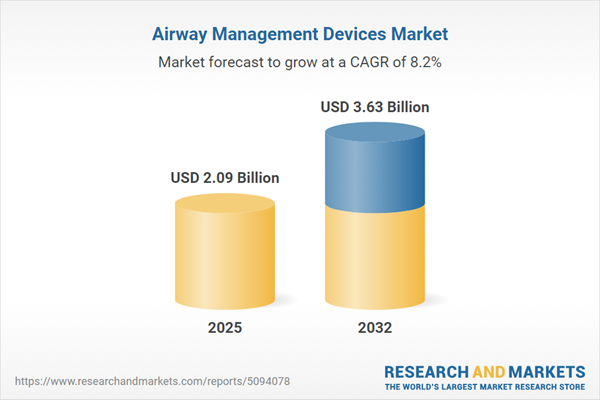Speak directly to the analyst to clarify any post sales queries you may have.
Senior leaders in healthcare procurement are facing a pivotal transformation in the airway management devices market, where rapid digitalization, safer materials, and regulatory evolution are fundamentally shifting purchasing priorities and care delivery standards.
Market Snapshot: Airway Management Devices Market Size and Dynamics
The global airway management devices market is projected to grow steadily from 2024 to 2032, driven by increased procedural demand and advancements in device engineering. This growth is accompanied by a shift among healthcare organizations toward data-driven decision-making, emphasizing improved patient safety and optimized procedural workflows. The integration of digital technology into procurement processes is central as hospitals and care centers invest in modernized systems. Evolving regulatory expectations and rising patient demands are prompting supply chain operations to focus on compliance and reliability, ensuring high standards are consistently met across acute, ambulatory, and at-home care settings.
Scope & Segmentation: Strategic Framework for Senior Decision-Makers
This market research report delivers comprehensive segmentation essential for informed executive strategy, enabling leaders to recognize market structures, anticipate both regulatory and clinical changes, and align investments for measurable value. Strategic recommendations guide organizations as they proactively shape procurement and care delivery to evolving global standards.
- Product Types: Endobronchial tubes, cuffed endotracheal tubes, uncuffed endotracheal tubes, intubation stylets, laryngeal mask airways, and laryngoscopes are examined for their use in both routine and advanced clinical scenarios, empowering decision-makers with clarity on product versatility and suitability.
- Material Types: Polyvinyl chloride, silicone, and innovative biocompatible materials are compared for patient safety, regulatory compliance, and user experience, providing insight into adoption trends and procurement considerations.
- Insertion Techniques: Methods analyzed include direct laryngoscopy, video-assisted procedures, and combined (hybrid) approaches, reflecting procedural diversity and supporting improvements in care delivery.
- End User Environments: The report details procurement dynamics in hospitals, ambulatory surgery centers, emergency response units, and home health segments, highlighting unique operational needs that influence sourcing and inventory management strategies.
- Applications: Emergency interventions, planned procedures, intensive care, medical transport, and at-home therapies are assessed for device adaptability to varied clinical requirements and patient segments.
- Patient Size Segments: The study addresses devices for adult, pediatric, and neonatal populations, ensuring executive strategies accommodate differing compliance and outcome considerations for each group.
- Geographic Regions: Analysis covers the Americas, Europe, Middle East, Africa, and Asia-Pacific, with attention to local regulatory environments and distinct supply chain structures, supporting region-specific planning and risk mitigation.
- Key Companies: In-depth competitor profiles are provided on Medtronic plc, Teleflex Incorporated, Ambu A/S, Becton, Dickinson and Company, Drägerwerk AG & Co. KGaA, Smiths Group plc, Olympus Corporation, Vyaire Medical GmbH, Karl Storz SE & Co. KG, and Cook Incorporated, outlining their strategic positioning for market stakeholders.
This segmentation ensures leadership can monitor distribution networks, stay aligned with global regulatory shifts, and proactively refine their approach as standards evolve across different care regions.
Key Takeaways: Insights for Senior Leaders in the Airway Management Devices Market
- Digital health integration empowers organizations to enforce clinical protocols more uniformly, resulting in improvements to both care quality and operational consistency.
- The widespread application of video laryngoscopy and comprehensive procedural training helps reduce clinical variability and improves team performance across settings.
- Adoption of advanced materials, particularly high-grade silicone, enhances patient comfort and enables broader functional application in complex clinical scenarios.
- Telemedicine technologies extend access to airway management expertise, supporting care continuity and responsiveness in remote or capacity-constrained locations.
- 3D printing capabilities support the development of patient-customized devices for individuals with anatomical complexities or heightened clinical risks.
- Efficiency in supplier collaboration and flexible procurement strategies ensures greater resilience, helping organizations adapt rapidly to potential supply chain disruptions.
Tariff Impact: Adapting Sourcing and Production Strategies
Recent changes in U.S. tariffs are prompting manufacturers to favor silicone-based components, supporting cost-efficiency and supply security. The shift has driven greater interest in nearshoring, deepened supplier partnerships, and led to more robust distribution frameworks, thereby reducing the risks posed by global trade and regulation shifts.
Methodology & Data Sources
The report combines direct contributions from anesthesia and intensive care practitioners with structured procurement surveys and detailed secondary research. Data validation includes shipping records and ongoing regulatory updates to maximize accuracy.
Why This Report Matters for Senior Decision-Makers
- Helps procurement executives align sourcing practices with the latest device regulations and emerging technology standards.
- Empowers C-level planners to optimize capital deployment and operational effectiveness as technology and policy landscapes continue to shift.
- Equips organizations with strategic flexibility, ensuring readiness to manage rapid market and regulatory changes.
Conclusion
This report enables senior healthcare decision-makers to confidently navigate complex procurement and compliance issues, ensuring strategies remain ahead of change in the evolving airway management devices market.
Additional Product Information:
- Purchase of this report includes 1 year online access with quarterly updates.
- This report can be updated on request. Please contact our Customer Experience team using the Ask a Question widget on our website.
Table of Contents
3. Executive Summary
4. Market Overview
7. Cumulative Impact of Artificial Intelligence 2025
Companies Mentioned
The companies profiled in this Airway Management Devices market report include:- Medtronic plc
- Teleflex Incorporated
- Ambu A/S
- Becton, Dickinson and Company
- Drägerwerk AG & Co. KGaA
- Smiths Group plc
- Olympus Corporation
- Vyaire Medical GmbH
- Karl Storz SE & Co. KG
- Cook Incorporated
Table Information
| Report Attribute | Details |
|---|---|
| No. of Pages | 187 |
| Published | October 2025 |
| Forecast Period | 2025 - 2032 |
| Estimated Market Value ( USD | $ 2.09 Billion |
| Forecasted Market Value ( USD | $ 3.63 Billion |
| Compound Annual Growth Rate | 8.1% |
| Regions Covered | Global |
| No. of Companies Mentioned | 11 |









